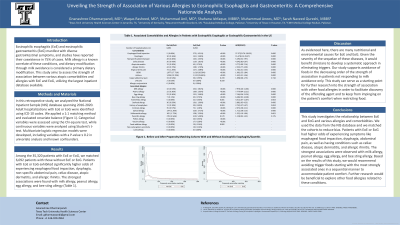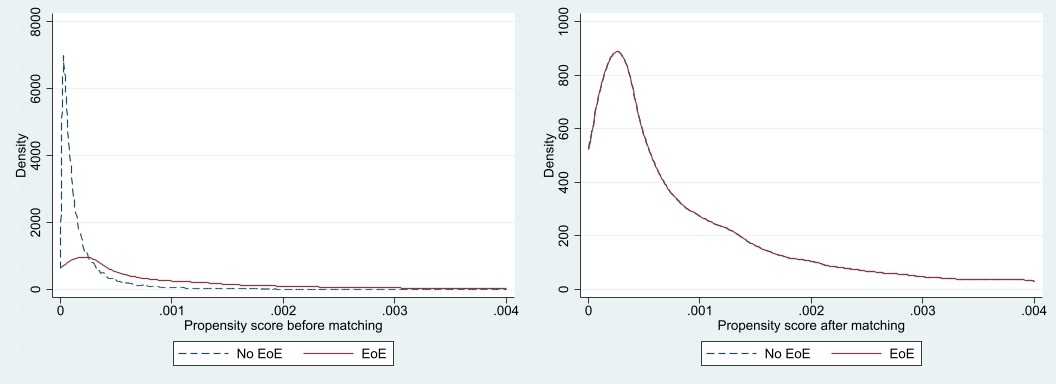Monday Poster Session
Category: Esophagus
P1846 - Unveiling the Strength of Association of Various Allergies to Eosinophilic Esophagitis and Gastroenteritis: A Comprehensive Nationwide Analysis
Monday, October 23, 2023
10:30 AM - 4:15 PM PT
Location: Exhibit Hall

Has Audio

Gnanashree Dharmarpandi, MD
Texas Tech University Health Sciences Center
Amarillo, TX
Presenting Author(s)
Gnanashree Dharmarpandi, MD1, Waqas Rasheed, MD1, Muhammad Anil, MD2, Shahana ishfaque, MBBS3, Sarah Naveed. Qureshi, MBBS4, Muhammad Anees, MD1
1Texas Tech University Health Sciences Center, Amarillo, TX; 2Beaumont Hospital, Dearborn, MI; 3Punjab Medical College, Faisalabad, Pakistan, Dearborn, MI; 4CMH Multan Institute of Medical Sciences, Multan, Pakistan, Beaumont, TX
Introduction: Eosinophilic esophagitis (EoE) and eosinophilic gastroenteritis (EoG) manifest with diverse gastrointestinal symptoms, and studies have reported their coexistence in 75% of cases. Milk allergy is a known correlate of these conditions, and dietary modification through milk avoidance is considered a primary dietary modification. This study aims to assess the strength of association between various atopic comorbidities and allergies with EoE and EoG, utilizing the largest inpatient database available.
Methods: In this retrospective study, we analyzed the National Inpatient Sample (NIS) database spanning 2016-2020. Adult hospitalizations with EoE or EoG were identified using ICD-10 codes. We applied a 1:1 matching method and evaluated covariate balance (Figure 1). Categorical variables were assessed using the Chi-square test, while continuous variables were analyzed using Student's t-test. Multivariate logistic regression models were developed, including variables with a P-value ≤ 0.2 in univariate analysis and known confounders.
Results: Among the 35,320 patients with EoE or EoG, we matched 6,092 patients with those without EoE or EoG. Patients with EoE or EoG exhibited significantly higher odds of experiencing esophageal food impaction, dysphagia, non-specific abdominal pain, celiac disease, atopic dermatitis, and allergic rhinitis. The strongest associations were found with milk allergy, peanut allergy, egg allergy, and bee sting allergy (Table 1).
Discussion: As evidenced here, there are many nutritional and environmental causes for EoE and EoG. Given the severity of the sequelae of these diseases, it would benefit clinicians to develop a systematic approach in eliminating triggers. Our study supports avoidance of foods in the decreasing order of the strength of association in patients not responding to milk avoidance only. This study can serve as a starting point for further research into the strength of association with other food allergies in order to facilitate discovery of the offending agent and to keep from impinging on the patient’s comfort when restricting food.

Disclosures:
Gnanashree Dharmarpandi, MD1, Waqas Rasheed, MD1, Muhammad Anil, MD2, Shahana ishfaque, MBBS3, Sarah Naveed. Qureshi, MBBS4, Muhammad Anees, MD1. P1846 - Unveiling the Strength of Association of Various Allergies to Eosinophilic Esophagitis and Gastroenteritis: A Comprehensive Nationwide Analysis, ACG 2023 Annual Scientific Meeting Abstracts. Vancouver, BC, Canada: American College of Gastroenterology.
1Texas Tech University Health Sciences Center, Amarillo, TX; 2Beaumont Hospital, Dearborn, MI; 3Punjab Medical College, Faisalabad, Pakistan, Dearborn, MI; 4CMH Multan Institute of Medical Sciences, Multan, Pakistan, Beaumont, TX
Introduction: Eosinophilic esophagitis (EoE) and eosinophilic gastroenteritis (EoG) manifest with diverse gastrointestinal symptoms, and studies have reported their coexistence in 75% of cases. Milk allergy is a known correlate of these conditions, and dietary modification through milk avoidance is considered a primary dietary modification. This study aims to assess the strength of association between various atopic comorbidities and allergies with EoE and EoG, utilizing the largest inpatient database available.
Methods: In this retrospective study, we analyzed the National Inpatient Sample (NIS) database spanning 2016-2020. Adult hospitalizations with EoE or EoG were identified using ICD-10 codes. We applied a 1:1 matching method and evaluated covariate balance (Figure 1). Categorical variables were assessed using the Chi-square test, while continuous variables were analyzed using Student's t-test. Multivariate logistic regression models were developed, including variables with a P-value ≤ 0.2 in univariate analysis and known confounders.
Results: Among the 35,320 patients with EoE or EoG, we matched 6,092 patients with those without EoE or EoG. Patients with EoE or EoG exhibited significantly higher odds of experiencing esophageal food impaction, dysphagia, non-specific abdominal pain, celiac disease, atopic dermatitis, and allergic rhinitis. The strongest associations were found with milk allergy, peanut allergy, egg allergy, and bee sting allergy (Table 1).
Discussion: As evidenced here, there are many nutritional and environmental causes for EoE and EoG. Given the severity of the sequelae of these diseases, it would benefit clinicians to develop a systematic approach in eliminating triggers. Our study supports avoidance of foods in the decreasing order of the strength of association in patients not responding to milk avoidance only. This study can serve as a starting point for further research into the strength of association with other food allergies in order to facilitate discovery of the offending agent and to keep from impinging on the patient’s comfort when restricting food.

Figure: Covariate balance before and after propensity matching
Disclosures:
Gnanashree Dharmarpandi indicated no relevant financial relationships.
Waqas Rasheed indicated no relevant financial relationships.
Muhammad Anil indicated no relevant financial relationships.
Shahana ishfaque indicated no relevant financial relationships.
Sarah Qureshi indicated no relevant financial relationships.
Muhammad Anees indicated no relevant financial relationships.
Gnanashree Dharmarpandi, MD1, Waqas Rasheed, MD1, Muhammad Anil, MD2, Shahana ishfaque, MBBS3, Sarah Naveed. Qureshi, MBBS4, Muhammad Anees, MD1. P1846 - Unveiling the Strength of Association of Various Allergies to Eosinophilic Esophagitis and Gastroenteritis: A Comprehensive Nationwide Analysis, ACG 2023 Annual Scientific Meeting Abstracts. Vancouver, BC, Canada: American College of Gastroenterology.
